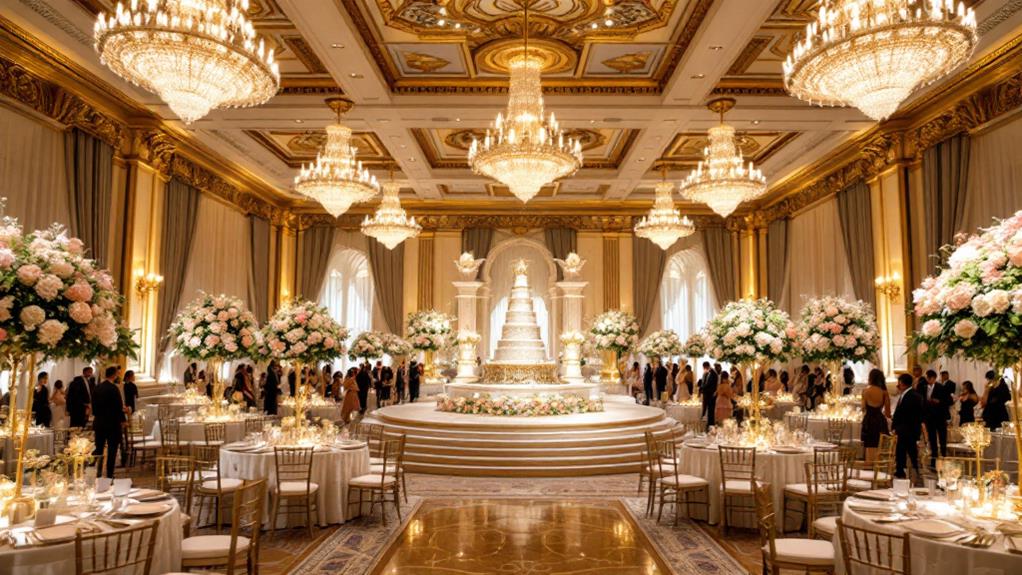Interesting Facts and History of Rubies: The Gem of Kings
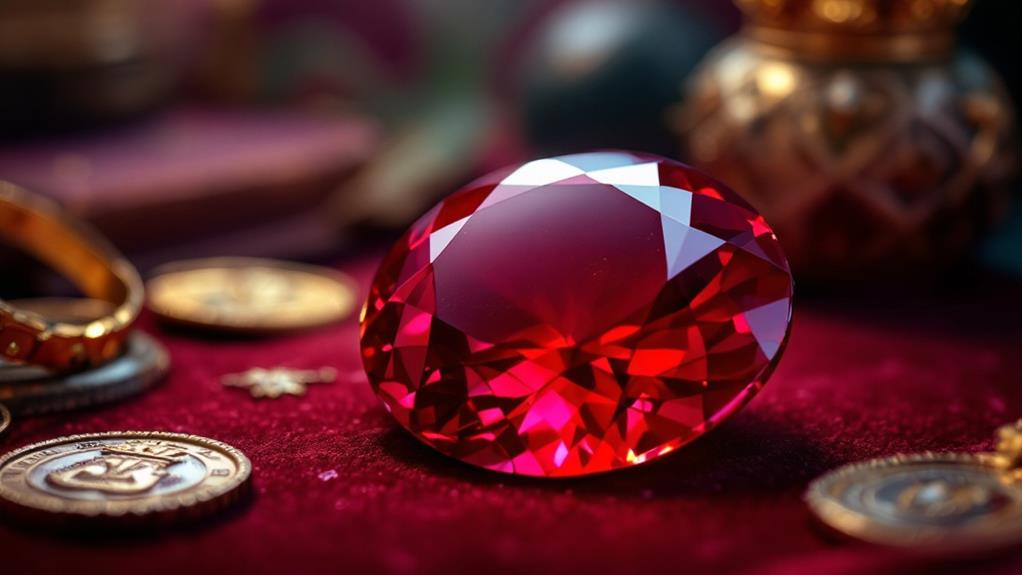
Rubies, often called the "Gem of Kings," captivate with their fiery red hue and profound cultural significance. Across ancient cultures, rubies symbolized passion, protection, and noble authority. In Hindu lore, they adorn the mythical Kalpa Tree. Warriors believed in their power to bestow invulnerability. Formed from corundum, their color comes from chromium, with the sought-after "pigeon blood" variety commanding top value. Historical figures like King Henry VIII cherished these gems. Ruby's durability is remarkable, ideal for daily wear. Behind their mesmerizing beauty lie tales of influence and mystique that you've only just begun to uncover.
Ruby Symbolism and Significance
Rubies, often celebrated as the "king of precious stones" in Hindu culture, carry profound symbolism and significance. You're probably aware that this gemstone's allure is tied to its striking red hue, representing passion and love. This makes rubies a favored choice for engagement rings and romantic gifts. Their natural beauty isn't just skin deep; rubies are also considered the birthstone for July, marking significant life events and milestones, like the 15th and 40th wedding anniversaries.
In ancient times, rubies were more than mere ornaments. They were revered for their protective powers. Many cultures, including ancient Burmese warriors, believed in their ability to provide invulnerability in battle. Wearing a ruby, especially on the left side of the body, was thought to safeguard one's rank and territory, warding off storms and misfortune. This symbolism extends to the mythical Kalpa Tree in Hindu lore, which bears rubies as its fruit, symbolizing power and wealth.
Mystical Properties of Rubies
Mystique surrounds the world of rubies, elevating them beyond mere gemstones into the domain of legend and lore. The ruby gemstone captivates with its fiery brilliance and has inspired mystical lore across cultures. Ancient civilizations believed these gems emitted their own inner light, so intense that they could boil water or shine through wrappings. This enchanting glow is partly due to the fluorescence of the ruby, especially at a wavelength of 694 nm, symbolizing the gem's inner fire.
In ancient Burma, warriors revered the Burma ruby, considering it a powerful talisman. They believed embedding these stones into their flesh granted invulnerability in battle. This mystical lore underscores the deep-seated belief in the ruby's protective powers. Folklore across numerous cultures attributes significant health benefits to rubies. They were thought to remedy bleeding, reduce inflammation, and even increase body warmth, enhancing the body's vigor and resilience.
Furthermore, some historical beliefs even endowed rubies with sentience. People thought these stones could feel emotions and influence their owners' fate, making them a symbol of power and mystery. As you investigate rubies, their mystical allure continues to captivate, offering a glimpse into a world where gemstones transcend their physical beauty.
Historical Associations With Rubies
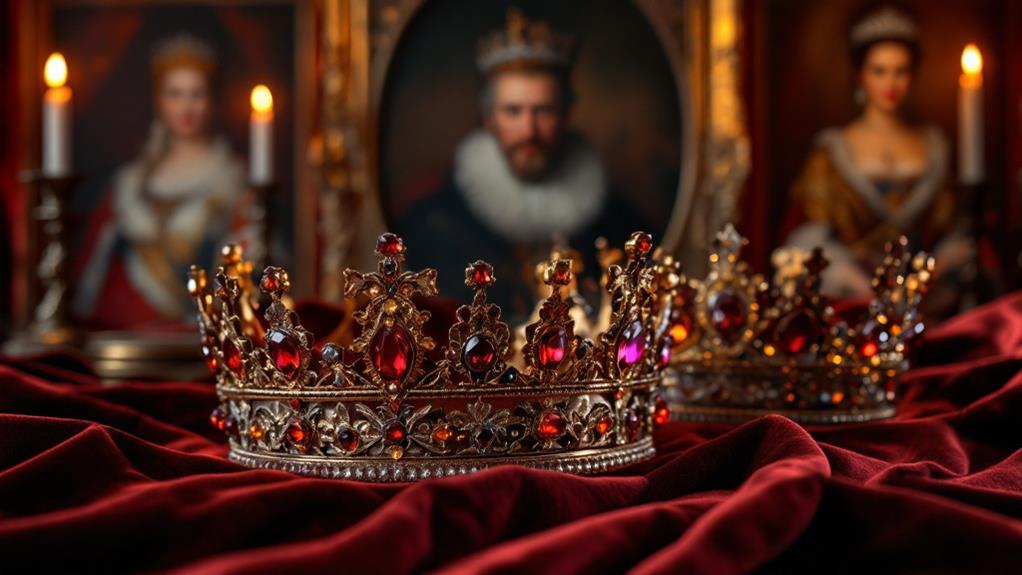
Throughout history, rubies have been intertwined with symbols of wealth and nobility, earning the revered title of the "king of precious stones" in Sanskrit, known as "ratnaraj." Welcomed by rulers and warriors alike, these fiery gems didn't just serve as ornaments but as talismans believed to offer protection and strength. During the Middle Period, Chinese noblemen adorned their armor with ruby gemstones, trusting in their power for protection in battle. This association with strength and security reinforced the ruby's esteemed status among the elite.
One of history's most famous rubies, the Black Prince's Ruby, although technically a red spinel, showcases the gem's allure. Gifted to Edward of Woodstock after the Battle of Najera in 1367, it later adorned British royal crowns, symbolizing authority and triumph. The DeLong Star Ruby, a magnificent 100.32-carat stone from Myanmar, further highlights the gem's historical prominence, now displayed at the American Museum of Natural History.
Rubies were also favored by King Henry VIII during the Renaissance, embellishing royal crowns and jewelry. They symbolized powerful emotions, love, and authority across diverse cultures, cementing their place in regal history.
Ruby's Vibrant Red Color
Thanks to their enchanting red hue, rubies stand out as one of the most visually striking gemstones. The secret behind a ruby's radiant red color is the presence of chromium. When chromium infiltrates colorless corundum, it transforms into the stunning red gem you admire. The more chromium present, the deeper and more intense the red shade becomes. However, if iron accompanies the chromium, it can lessen the intensity of the color, making the ruby appear less brilliant.
In the gemstone market, the intensity of a ruby's color is vital for determining its value and desirability. Among the many shades, the "pigeon blood ruby" is the most coveted. This specific variation in color boasts a rich, bright red with slight blue undertones, making it exceptionally rare and valuable.
Rubies don't just come in one shade. You'll find variations in color, including orange and pink tints, depending on the trace elements present during their formation. These variations add to the complexity and allure of rubies, ensuring there's a perfect hue for every taste. When choosing a ruby, keep an eye on the intensity of color, as it greatly influences the gem's worth.
The Origin of Rubies
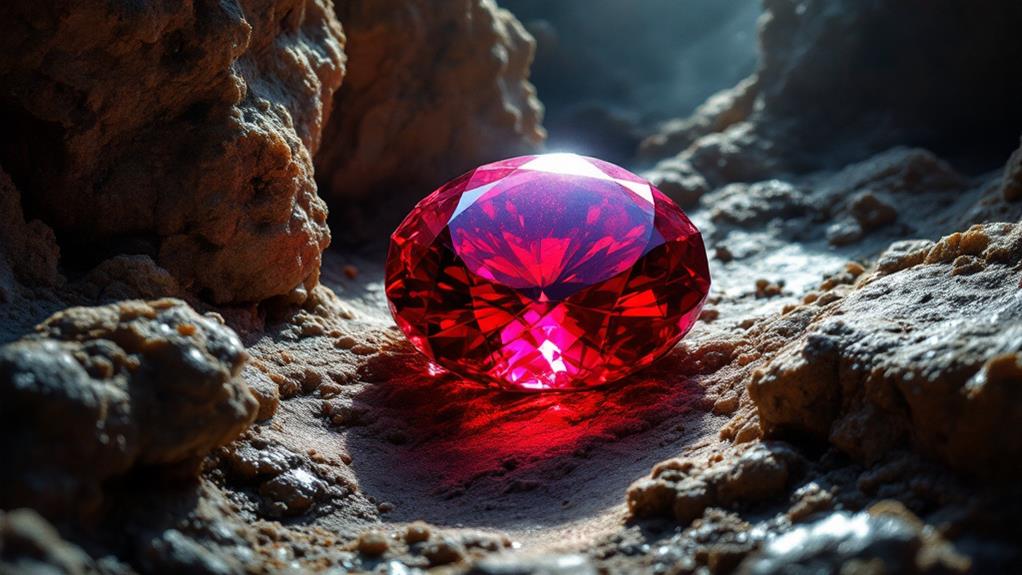
Rubies, the dazzling red gemstones that have captured human fascination for millennia, originate from the mineral corundum. You might be intrigued to know that these enchanting gems form under extreme heat and pressure, with their red hue primarily due to chromium. The mesmerizing history of rubies dates back to ancient times, with the initial known reserves found in the Mogok region of Burma (now Myanmar) around 2,500 B.C. This region has long been celebrated as a source of high-quality rubies, and its rich deposits have played a crucial role in the gemstone's storied past.
In ancient history, Burmese warriors held a deep belief in the protective powers of rubies. They would embed these gems in their flesh, seeking invincibility in battle. This practice highlights the revered status rubies held across cultures and times.
Here's a quick look at some fascinating ruby facts:
- Ruby: Derived from "ruber," Latin for red, reflecting its fiery color.
- Burma: A historical source known for producing some of the finest rubies.
- Ancient warriors: Embedded rubies for protection and strength.
- Historical texts: Featured in the Bible, symbolizing wisdom and value.
Rubies continue to be cherished for their beauty and historical significance.
Rubies and Their Sister Gemstone
Rubies share a intriguing connection with their sister gemstone, the sapphire, as both derive from the mineral corundum. What sets rubies apart is that they're the red variety, thanks to the presence of chromium. This gives rubies their signature, lively red hue. In contrast, sapphires boast a broader color palette due to other trace elements like iron and titanium within corundum. The distinction between rubies and their pink sapphire cousins mainly lies in color intensity. Darker shades with rich saturation qualify as rubies, while the lighter shades are classified as pink sapphires.
In the U.S. market, rubies must meet a strict color saturation standard to earn their classification, greatly impacting their desirability and value. This requirement often makes an expensive ruby a sought-after gem. The rarity and deep, enchanting color of genuine rubies mean they usually command higher prices compared to sapphires. Even though both gemstones share a common origin, their perceived value and allure can differ greatly. While sapphires come in diverse shades, including blue, yellow, and even colorless variants known as white sapphires, it's the vivid red of rubies that continues to fascinate collectors and enthusiasts worldwide.
Ruby Hardness and Durability
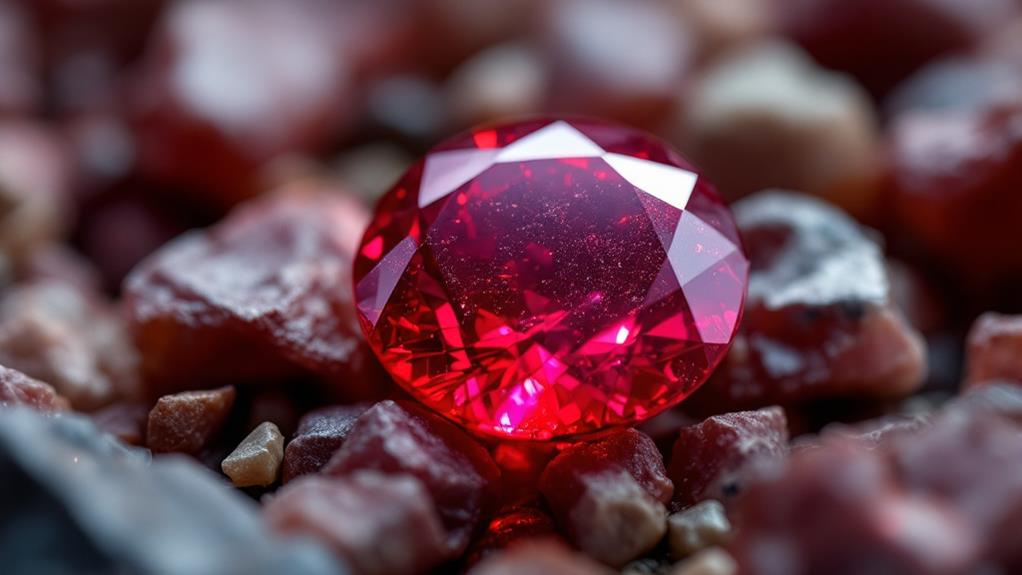
Rubies' remarkable hardness earns them a prestigious spot among the toughest gemstones, scoring a solid 9 on the Mohs scale. This impressive score, second only to diamonds, highlights their incredible durability. Thanks to their resilient crystalline structure, rubies can withstand scratches and chipping, making them perfect for everyday jewelry like engagement rings. You'll find that their strength against wear and tear elevates their appeal in fine jewelry, where longevity is a priority.
When selecting a ruby, consider the following:
- Ruby Hardness: With a 9 on the Mohs scale, these gemstones are extremely hard.
- Durability: Their robust nature makes them resistant to everyday wear and tear.
- Crystalline Structure: This structure gives rubies their impressive resilience.
- Engagement Rings: Ideal for rings due to their strength and enduring beauty.
However, it's significant to keep in mind that not all rubies are created equal. Some may exhibit cracks and fissures because of variations in chromium content during formation. Despite this, the comprehensive strength and resilience of rubies make them a top choice for those seeking a gemstone that combines beauty with durability. Regardless of it's for an engagement ring or another piece of fine jewelry, rubies deliver both elegance and toughness.
Notable and Famous Rubies
In the domain of gemstones, a few rubies stand out not only for their beauty but also for their fascinating stories. The Sunrise Ruby, known for its vivid "pigeon's blood" color, is the most expensive ruby ever sold, fetching an astounding $30.42 million at auction in 2015. Weighing 25.59 carats, it serves as a timeless symbol of love and passion. Another remarkable ruby, the DeLong Star Ruby, located in Burma, weighs 100.32 carats. It's famous for its star-like optical effect and can be admired at the American Museum of Natural History in New York City.
Let's not forget the Liberty Bell Ruby, one of the largest known rubies, weighing a staggering 8,500 carats. This unique sculpture, adorned with 50 diamonds, was sadly stolen in 2011 and remains missing. Meanwhile, the Black Prince's Ruby, though actually a red spinel, holds historical significance. Weighing 170 carats, it has been worn by English monarchs and is now set in the Imperial State Crown. These rubies, regardless of their size, beauty, or history, continue to captivate people around the world, each telling its own intriguing story.
Global Ruby Sources and Trends
In regards to sourcing the finest rubies, Myanmar (Burma) takes the spotlight with its legendary "pigeon blood" red gems known for their exceptional clarity. With respect to where your ruby comes from, you'll find a world of diversity. While Myanmar leads with its lively beauties, Sri Lanka offers its own rich history of ruby production, making it a traditional gift of elegance. The largest mined ruby in the world has added to the allure of these enchanting gemstones, sparking interest and admiration globally.
You'll find other notable sources like:
- Thailand and Cambodia: Known for high clarity and superb tones, these rubies are highly desirable.
- Tanzania and Mozambique: Offering purplish undertones, these African rubies provide unique color variations.
- Sri Lanka: Besides its historical significance, it contributes to the global gemstone market with its distinct gems.
- Market Trends: The demand for Tanzanian corundum is rising, impacting local economies and practices.
The geographical diversity of ruby sources contributes to varying qualities and characteristics. As the gemstone in the world, rubies continue to intrigue collectors and enthusiasts, influencing market trends based on rarity and desirability.


